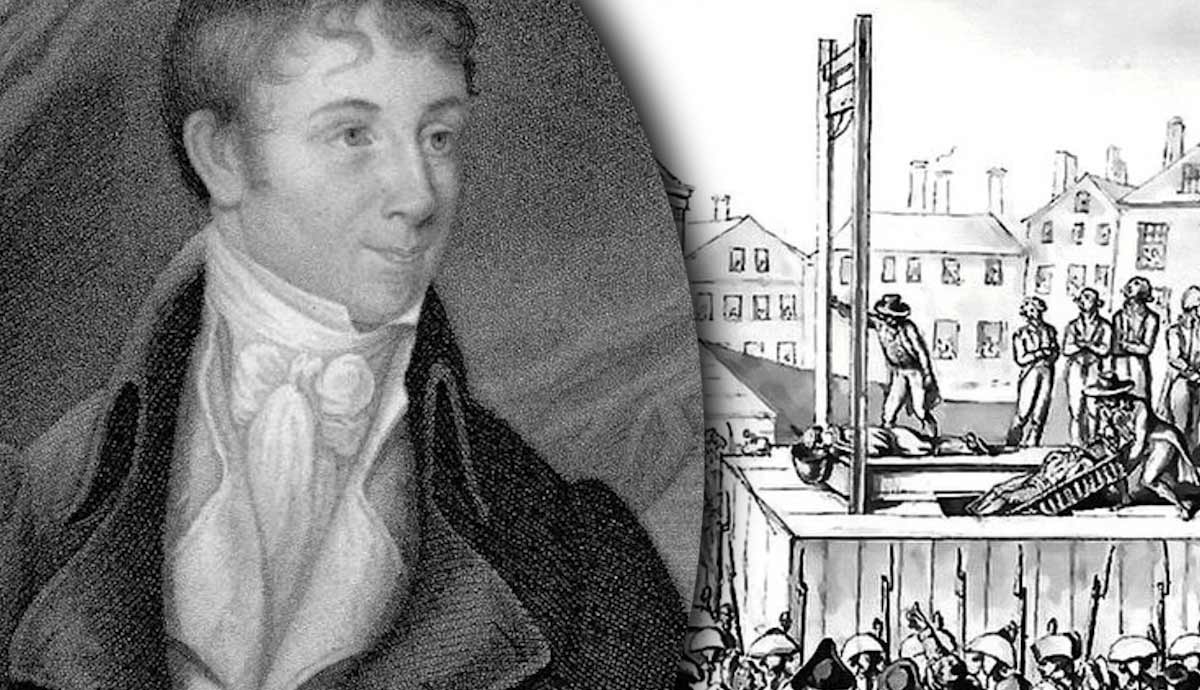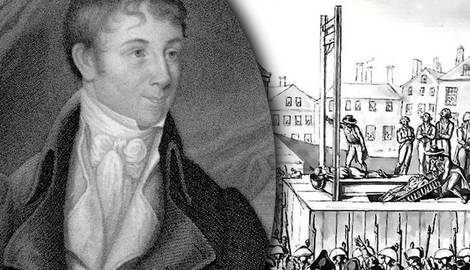
A pioneer of American literature, Charles Brockden Brown, was the first American to earn a living from writing. His debut novel, Wieland, is widely considered the first American gothic novel, paving the way for subsequent legends in the genre, including Edgar Allan Poe and Nathaniel Hawthorne. While at once an intriguing horror and mystery story, Wieland also presents didactic elements centered on early American epistemological concerns. In it, Brown questions the validity of knowledge acquired from either extreme of a contemporary clash between religious zeal and rational skepticism.
Charles Brockden Brown: Early Life and Influences

From an early age, Charles Brockden Brown (1771-1810) became intimately familiar with the complicated relationship between religion and rational politics in America. Born to a Quaker family in Philadelphia just before the start of the American Revolutionary War, his earliest experiences involved an empirical education in the tenets of Quakerism, as well as in the irrationality of systematic paranoia.
Quakers were a notoriously pacifist denomination, believing in tolerance and equality. As members of this faith, Brown’s parents held a neutral position in the turbulent political discourse leading up to and during the Revolution. Neither for the cause nor against it, they avoided political involvement altogether while continuing to conduct their business and live their lives. As a result, Brown’s father, a relatively successful merchant, was accused of war profiteering. At age six, Brown witnessed his father’s arrest and exile to Virginia at the hands of the revolutionary army. He was incarcerated there, along with a group of fellow Quakers, ultimately for refusing to pledge allegiance to the colonies’ patriotic cause. The origin of this arrest, however, lay with the members of the Continental Congress, who deemed Quaker pacifism a threat to their revolutionary aims (Ringe, 1991).
From this event, it appeared to Brown that even those practicing rationalism in the “Age of Reason” were not exempt from the human experience of suspicion and insensibility—attributes typically associated (by the rational crowd) with religiosity (Paine, 1794). This lesson and the trauma of such a formative incident remained with Brown for the entirety of his life and laid a foundation for issues he would later explore throughout his writing career (Kafer, 2004).
The Legacy of Charles Brockden Brown

As Brown matured, he became influenced by the works of William Godwin and Mary Wollstonecraft, furthering his progressive viewpoints in the realms of rationalism, proto-feminism, abolitionism, and general tolerance for diverse opinions, views which he had garnered during his education from the Quaker Friends Latin School in Philadelphia. In 1793, after having completed an apprenticeship with one of the most notorious attorneys in Philadelphia, Alexander Wilcocks, Brown decided to alter course and pursue a career more in line with his burgeoning ideologies and passions—philosophical inquiry and writing (Ringe, 1991).
While it is a contested claim among scholars that the American novel originated with Brown’s work (earning him the title in some circles as the “Father of the American Novel”), it is widely accepted that he was the first American to successfully make a career of writing, and moreover, that he was the first to apply the increasingly popular gothic genre to the American literary scene (Hogle, 2002).
The Gothic Revival & Its American Manifestation
The term “gothic” originates from the medieval Germanic tribe, the Goths, who played a major role in the destruction of Rome in the 5th century CE. Because the Gothic tribe flourished primarily during the Dark Ages, there is little historical documentation about their culture and exploits.

From this void of information arose myths, not only of the Goths but of the medieval era at large, which they ultimately came to represent. During the Renaissance, the word “gothic” was used as a descriptor for anything associated with the medieval world, signifying the barbaric and archaic. By the 18th century, however, English politicians began romanticizing the gothic era as an ideal period in British history where modern, civilized values existed in their purest state (Punter, 2004; Spooner, 2007).
The Gothic Revival emerged from this laudation of the medieval, with the myths and legends surrounding that elusive historical period. Suddenly, it was vogue to fashion one’s home after medieval models, with pointed arches, spires, and gargoyles built or veneered in cold, gray stone. Dimly lit hallways and staircases marked by flickering lamps and shifting shadows all served to produce atmospheres touched by the sublime—a strangely beautiful, albeit fearful, pleasure of the gloom and mysteriousness vital to the gothic ideal (Spooner, 2007).
Gothic tradition in English literature is widely recognized to have originated with the publication of Horace Walpole’s novel, The Castle of Otranto (1764), which was the first to incorporate gothic features in literary art, including medieval structures or ruins, dark and foreboding landscapes, and supernatural encounters. The popularity of this genre expanded throughout the British empire and, by the end of the 18th century, across the newly established United States as well (Spooner, 2007). From there, it was only a matter of time before American authors would adapt the form to reflect a uniquely American landscape, both physically and ideologically. And it was Charles Brockden Brown’s novel, Wieland; Or, The Transformation that initiated this move, doing so by applying traditionally gothic elements to American thematic concerns.
Wieland’s Era: An Age of Reason & Religion

One of the major concerns rumbling throughout the United States at the time was an ideological conflict between the rational and the religious. Between the proponents of the Enlightenment, those who believed in reason and empirical evidence as the only avenue to truth, and its metaphysically inclined opponents, those who continued to advocate for the religious principles and supernatural experience that defined so much of the American past.
At the heart of this clash was a pervasive Enlightenment argument that knowledge could only be attained through reason and empiricism. That is, knowledge derived from the senses. To the rationalists, only what could be seen and touched and proven by logical deduction could possibly be true. To the religious, however, truth had always existed in the unseeable and the untouchable and, indeed, was often unexplainable.
Moreover, to the rationalist, reason was the only way to progress, to attain a higher level of morality and civility. Meanwhile, to the religious, moral development was an invisible process predicated on the will and whim of an invisible God.
Indeed, the Enlightenment did bring about many progressive revolutions, resulting in the victory and expansion of democratic ideals—declarations of independence from tyrannical rulers, the toppling of monarchies and the institution of democracies in their place, and the undeniably altruistic pursuit of liberty and equality for every human being.
The Enlightenment’s Dark Underbelly

While reason seemed to beget this lovely offspring, there was also an unignorable dark side to the movements enabled and inspired by enlightenment thought. Tens of thousands of French citizens, common and aristocratic alike, were executed during the French Revolution. Cries for rights quickly turned to violent demands, anarchy, and destruction. Paranoia swept through the ostensibly enlightened population and led them to chaotic ends.
In the United States, the Declaration of Independence decreed, “all men are created equal,” possessing a right to liberty, yet hundreds of thousands of people remained enslaved under American laws. To the religious mind, democracy itself seemed a dangerous ideal, with its core principle, vox populi, vox dei, replacing the voice of God in the rule of nations with the voice of a people prone to paranoia and (as in the case of the French Revolution) potentially self-destruction.
From this paradoxical era, this age of altruism and malice, of progress and regress, of reason and paranoia, arose a question: Can the senses be trusted? For many Americans, even those uncategorized by extremes, there was an underlying fear associated with rationalism—that it could tip too far and turn instead to chaos and destruction. Equally so, however, the same could be said about religion.
In fact, it was religion that had spurred the paranoia-driven witch trials across New England during the 17th century. It was religion that had oppressed, exiled, and murdered colonists, Natives, and the enslaved for centuries under puritanical rule. And it was religion that had prompted a young farmer in eighteenth-century New York to murder his wife and children at the apparent command of God—the true and terrifying story that inspired Charles Brockden Brown to write America’s first gothic novel.
Reason had apparently proven these religious atrocities wrong, but was reason itself any better?
Wieland: An Exploration of American Morality

How better to explore this question than through a form naturally concerned with the unreasonable? To a heavily rational world, gothic literature had become a mode of returning to the supernatural to evaluate the questions that reason could not explain, questions that seemed to exist beyond the limits of human knowledge, both rational and religious.
Admittedly an instructive tale, Brown (1798/1991) opens Wieland with an advertisement stating that the story’s purpose “aims at the illustration of some important branches of the moral constitution of man” (p. 3). Given the novel’s historical context and thematic concerns, it is apparent that the moral issues he wishes to unpack involve the era’s conflicting methods of discovering and verifying truth, which he illustrates by juxtaposing the foil characters, Theodore Wieland and Henry Pleyel, at the start of the novel:
“Moral necessity and calvinistic [sic] inspiration were the props on which [Wieland] thought proper to repose. Pleyel was the champion of intellectual liberty, and rejected all guidance but that of reason” (p. 28).
Wieland represents the religious side of the argument, and Pleyel, the rational. Brown then weaves a compelling and horrifying tale that seems to undermine both modes of discovery.
The Plot & Its Surprising End

Wieland is a devout Calvinist who enjoys a simple life in rural Pennsylvania with his wife and children, his sister, Clara, and his rationalist friend, Pleyel. Their gatherings are harmonious and lovely until the arrival of a mysterious figure, Carwin, which coincides with a series of supernatural events. Voices with no origin begin to echo throughout the home and landscape, predicting the future, threatening death, mimicking family members, spreading lies.
Over time, these voices drive Pleyel to abandon his love interest, Clara, believing he had overheard her admitting to licentious behavior. Trusting that his auditory senses could not deceive, he finds no logical explanation apart from empiricism. Then, the voices drive Wieland to murder his wife and children, believing he had been ordered by God to do so. Relying on faith as his compass for truth, he finds no explanation apart from a divine encounter and mandate.
As the story unfolds, we learn that the mysterious guest, Carwin, is a ventriloquist. That an explanation does, in fact, exist between the senses and the supernatural. That both reason and religion are susceptible to deception, and that neither should be trusted in the extreme.
Interestingly, while Carwin’s voice propelled the family to many disastrous ends, there remains some ambiguity. Carwin denies commanding Wieland to murder, which implies the presence of a truly unknown and unexplainable voice.
Perhaps that is part of Brown’s point—that some things in this world may exist without any explanation at all (or at least no explanation that humanity is capable of attaining), and that a nuanced perch between rationalism and metaphysics is perhaps the wisest position of all.
Bibliography
Brown, C. B., (1991). Wieland and Memoirs of Carwin the Biloquist (J. Fliegelman, Ed.). New York: Penguin Group. (Original work published 1798)
Hogle, J. (Ed.). (2002). The Cambridge Companion to Gothic Fiction (Cambridge Companions to Literature). Cambridge: Cambridge University Press.
Kafer, P., (2004). Charles Brockden Brown’s Revolution and the Birth of American Gothic. Philadelphia: University of Pennsylvania Press.
Paine, T., (1998). The Age of Reason. Citadel Press. (Original work published 1794)
Punter, D., Byron, G. (2004). The Gothic. United Kingdom: Blackwell Publishing.
Ringe, D. A., (1991). Charles Brockden Brown, Revised Edition. Boston: Twayne Publishers.
Spooner, C., McEvoy, E., (Ed). (2007). The Routledge Companion to Gothic. New York: Routledge.








